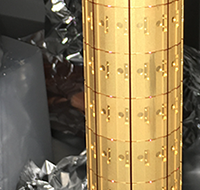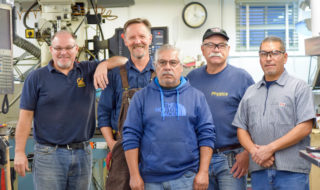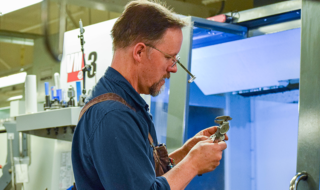When it has to be done yesterday, the physics world turns to Berkeley
If the big telescope in Antarctica breaks, or the CERN supercollider needs a part, Warren Carlisle gets the call
October 23, 2018

Physics Lab supervisor Warner Carlisle and his crew love the deadline pressure of their jobs. (UC Berkeley photos by Irene Yi)
So there you are, snug in the workspace of the South Pole Telescope, cozily oblivious to the -73 degree weather outside. A zillion miles away from, well, pretty much anywhere.
You’re charting the cosmos, looking for dark matter and attempting to add something coherent to the conversation about the birth of the universe. And then the vacuum pressure fails and you are lord (or lady) and master of a broken and unusable machine.
Who are you going to call?
Betting odds would be that your first call is likely to be to Warner Carlisle and his crew at UC Berkeley’s physics lab, deep in the underbelly of LeConte Hall. For researchers, scientists and technicians from Athens to Antarctica, Warner & Co. are on speed dial.
That call from the South Pole Telescope came in last Monday, Oct. 15. With the season for prime South Pole Telescope use quickly coming to an end, the rush was on. The Berkeleyans had five days to produce a couple of hexagonal pieces of metal the size of an extra-large pizza, with their ribs accurate to within 1/1,000th of an inch.They will hold the telescope’s lenses in place.
“Things just crashed,” Carlisle said mid-production. “It has to be made, then gold plated. And it has to be done by Friday. It’s pretty complex. It’s the kind of pins-and-needles work that we do here.”
‘We do the things nobody else wants to do’
Frankly, get-it-done-yesterday jobs come calling all the time. The parts went out Friday, Oct. 19, carried in a suitcase by a researcher heading to the South Pole. FedEx and UPS don’t make this kind of a run, so researchers can wind up doubling as couriers.
It was just over a month ago that a call came from Geneva. CERN, the European Organization for Nuclear Research that runs the largest particle physics lab in the world, had gotten itself into a bit of a bind.
The ALPHA Beam Line was on the verge of shutdown. Not what you want to have your equipment when you are dealing with antimatter. If a fix couldn’t be done on time, ALPHA was going to be shut down for a two-year maintenance upgrade. Needed were 24 electrodes to work in the anti-hydrogen trapping system.
“The tolerance on that is small, down to two-tenths of a thousandth of an inch,” Carlisle said. “We asked some of our affiliates if they wanted to do this. They declined.”
Hey, that happens. Carlisle has been working at Cal for 27 years, and he’s been the physics lab supervisor for the past seven. Most of his crew of machinists — Abel Gonzalez, Gordon Long, Tommy Gutierrez and Jesse Lopez — has double digit years on the job in Berkeley. They like what they do. Doing a routine job just isn’t as much fun as having to produce under pressure.
“Our shop is willing,” Carlisle said. “We do the things that nobody else wants to do.”
So the crew, led by Long, got to work. And the last of the 24 finely milled, gold-plated electrodes went into place in the ALPHA-G project in CERN in the last week. And the pursuit of science picked up again, fueled by the Berkeley crew’s five mechanicians, workers with college and technical training and certifications in precise scientific work. These workers help get the concepts of Ph.D.-level theorists into an actual usable object.
And the demand for the quick turnaround on top of the needed precision?
“It’s like that a lot of the time here,” Long said. “It makes it interesting.”
Inspector Gadget would be jealous
The first thing you do when you walk down a slightly inclined driveway and open the door into the B Level at LeConte is to put on safety glasses. You may not need them, depending on that moment’s work in progress, but 30 minutes later, you could be grateful for the protection they provide as sparks and metal start to fly.
As you look around, you see a floor inundated wall-to-wall with machines that would make Inspector Gadget jealous, complete with shelves stacked high with attachments that enable the machines to change directions and multitask. Moving farther back there are shelves loaded with metals and alloys that will, in time, be turned into scientific instruments that will not just travel the world but define it.
“I don’t know that there’s any place in the world that can produce what we do as efficiently and as quickly as we do,” Carlisle said. “We’re pretty much of a one-of-a kind go-to shop, worldwide. The staff is energized. We’re a family. The crew has worked in other labs on campus, as have I. I’m able to pick the best of the crop.

These 24 gold-plated electrodes manufactured by the UC Berkeley physics lab saved the day for CERN anti-matter scientists. (Photo courtesy of CERN)
“We have one guy from the chemistry lab, two more who have come from Berkeley’s Mechanical Engineering lab. Myself, I was in the ME department, but also was in the electrical engineering group, and I came to Berkeley with previous physics fabrication background from the Maxwell and Cyclotron corp research labs.”
Carlisle has worked in labs all over the campus in his 27 years in Berkeley. But the physics lab was always his goal. He had just finished his machinist apprentice work in the mid-1970s when he mother suffered a bout with cancer.
“I heard of a firm that was developing some medical isotopes to treat those related cancers,” he said. “So I jumped ship and went to work on cyclotrons. And I fell in love with the physics world.”
His mother, Norine, would die two years later. By that time, Carlisle’s path in hands-on science was set.
In 1992 a job in the chemistry lab at Berkeley opened up. Just to get the experience and to get his foot in the door, Carlisle grabbed it. Over time, he migrated to physics, first working on the floor of the union shop, then for the last seven years serving as supervisor.
A lab where history has been made
He was joining a facility with more than a little history attached. The first physics class at Berkeley was taught in 1873, five years after the university opened. The first doctorate in physics was awarded in 1903. Physics classes were held in South Hall until they migrated to the newly built LeConte Hall in 1924.
Ernest Lawrence joined the faculty in 1928 and ran it for two decades. Along the way he invented the cyclotron, earning the 1939 Nobel Prize in Physics. But he didn’t do it alone. It took a crew, predecessors of Carlisle’s group, to do the manufacturing that made the cyclotron a reality after it had been a concept. Lawrence also studied radiation, starting a “rad lab” situated between LeConte and the Campanile that has since moved up the hill to become the Lawrence Berkeley National Laboratory.
When he wasn’t spending time helping to invent the atomic bomb at Los Alamos in New Mexico, Robert Oppenheimer was on staff in Berkeley from 1929 into the 1940s.
“We know we’re carrying a lot of history on our backs here,” Carlisle said. “I’d like to think we do right by them.”

The physics crew includes Tommy Gutierrez, Gordon Long, Abel Gonzalez, Warner Carlisle and Jesse Lopez.
While honoring the past, the present is relentless. Funding is an issue. Last week saw the lab ask for $1.8 million from the university for the professional lab and another $800,000 for the student lab upstairs. The pro lab is without a 3D printer, and other machines are aging — one lathe was designed using 8-inch floppy disks that went out of style in the 1980s. State of the art it isn’t, even if the crew makes it work.
For all of that, the calls reeking of urgency don’t let up. The suitcased shipment to the South Pole Telescope went out Friday, on time. Almost simultaneously came another call from Antarctica. More damaged parts. Rush order, as always. Delivery by yesterday would be good.
“We weren’t counting on that,” Carlisle said. “It’s another rush job. We’ll move some stuff around, farm some other stuff out, but we’ll get it done.”
Getting it done has its rewards. An email from CERN’s ALPHA spokesman, Jeffrey Hangst hit the inbox over the weekend. It talked about the “beautiful and time-critical work” the lab had done for the ALPHA-G project, which just finished installation over the weekend.
“I was the originator of the design concept for these very thin-walled parts, and I am fully aware of the challenges associated with fabricating them,” Hangst wrote. “I am very impressed with your work and particularly grateful that you could deliver on a nearly impossible time schedule.”
For the physics lab, it’s the Berkeley way.
